|
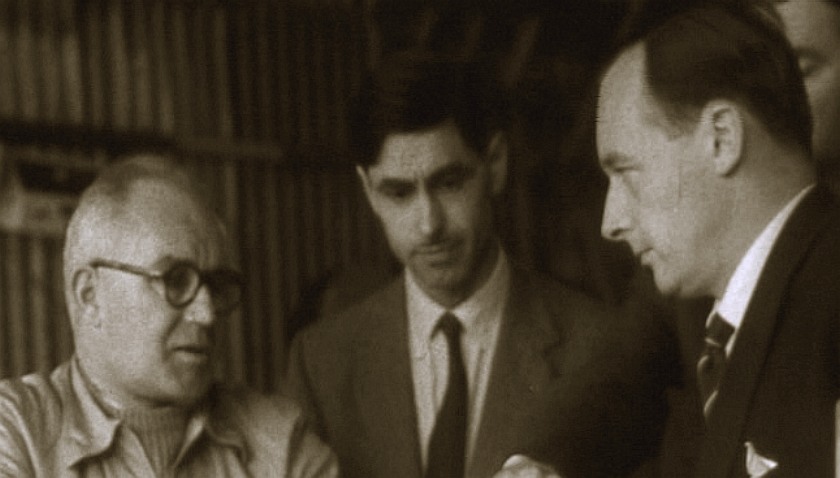
Leo
Villa, Ken Norris and Donald Campbell in the 'boat shed' discussing design
details
THE PARTNERSHIP:
DONALD CAMPBELL, KEN NORRIS and LEO VILLA - JETSTAR 1967
Like
his father, Donald Campbell developed a taste for life on the water after
the record breaking. The Jetstar prototype was conceived by
Donald
as a means of producing a pleasure boat that would reduce the risk of injury from normal propeller driven craft, by using
shrouded impellors in a water jet.
During the 1966/67 world water speed record attempt, Campbell used the Jetstar as a personal runabout on Lake Coniston. He would take journalists for promotional trips, and entertain the crowds on days when Bluebird could not run. The team also used the boat to evaluate Bluebird at close quarters whilst under way.
Campbell had planned to promote the Jetstar alongside a world record-beating Bluebird at the 1967 London Boat Show. The show opened on 5th January - but on 4th January Bluebird crashed, and Campbell was killed.
After Donald Campbell’s death, a fibreglass version of the Jetstar was produced by the Norris Brothers in moderate numbers, at a selling price of £1200, a much higher cost than an equivalent
propeller driven
boat, but for a lot more performance.
The Jetstar hull was designed by Peter Milne. It is of cold moulded timber construction, fitted with an 80hp V4 Evinrude power head, installed on its side and linked to a Hamilton Jet-drive intake. From there it leads to the jet outlet, through which the flow of water is directed, with a system of flaps incorporated to control boat
speed.
The smart and innovative little
Jetstar with a blue hull and mahogany decks was intended to provide Donald
Campbell with future financial security. Designed for families it had a top speed of 40mph, and used hydrojet technology rather than a propeller to make it safe for towing
water-skiers.
Most people think that the Jetstar makes a very appealing small motorboat.
After Campbell’s passing at Coniston the Norris brothers continued working on his design and a reasonably successful version of the boat
reached the market. The original Jetstar remained with the brothers until
Andy Stirland acquired her in 2003, and in that year she finally made it to the
London Boat
Show,
being displayed on the Classic Boat Magazine stand. It is ironic that the day after his death Campbell had been due to attend the 1967
London Boat Show promote his new product.
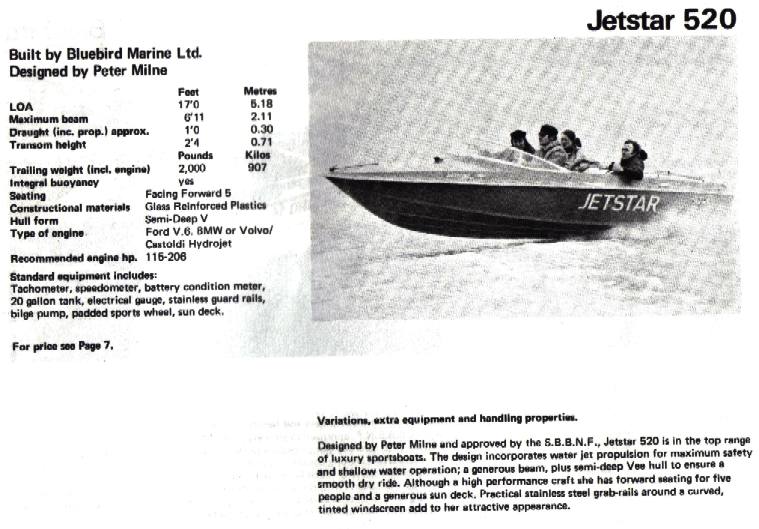
ENTHUSIASTS
Leo Villa (his chief engineer and friend) produced a fibreglass version aimed at the family man for around
£850, and was filmed being demonstrated on a lake in Essex by Pathe News.
The Jetstar was put into production by Bluebird Marine Limited between 1970 and 1980 by Gordon Thurkettle (another member of the Campbell team), and about 100 of these boats were built during this time. On demise of the company the moulds were sold on to
BW Marine, Southwater, Horsham, Sussex.
These moulds could once again be available to/or via Bluebird Marine Limited for
limited edition production.
Alan
R says that he worked with Gordon Thurkettle from 1970 to 1984 building the
Jetstars. He confirms that the first boat was made of wood and powered by an
Evinrude V4 75hp power head driving a
Dowty-Hamilton jet through an
oil cooled right angle drive gearbox designed by the Norris Brothers who had
designed both the Bluebird K7 boat and CN7 car for Donald Campbell with which he set both water and land speed records.
Bluebird Marine was funded by the Norris Brothers and Leo Villa was the general manager until he retired.
The first production Jetstar was a 4 seat boat with a flat windscreen and powered by a 1500cc ford as the
cross flow 1600 was not at that time available. The first 1600 used a mangoletsi marinisation with an oil cooler pipe through the sump.
1970 saw the deck change to give a wrap-round windscreen. This boat became the
Jetstar 400.and very little changed from then on. A cheaper 2 seat version mainly just for skiing was called the
Jetstar 390. An alternative 2 litre BMW engine was offered giving
130 bhp. Changing the impellor to the coarse version gave 36 knots with an incredible amount of thrust - enough to easily pull up
2 deep water skiiers. Castoldi 04 jets were also used which raised the top speed to over 40 knots but with lower static thrust
for pulling up skiiers. We also produced a 17' jetstar 520 which became the 525.This boat used the castoldi 05 jet,the most
common being the 3 litre ford V6.
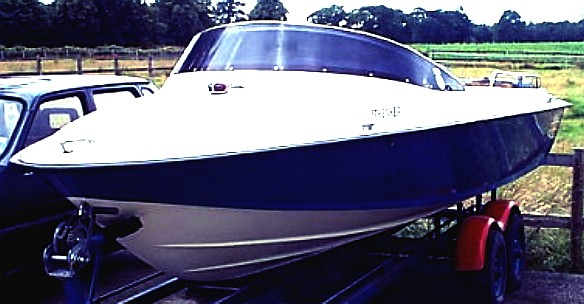
A
later Jetstar 520
BLOGGS
Re: Jetstar boats
-
Reply #3 on: February 17, 2012, 12:32:12 pm by Alan R
Hi Mark. I assume you have the 3 litre V6 engine coupled to the 05 jet. This should give a top speed of 45 mph @ 5000 rpm with 29/37 gears fitted or 4800 rpm with
28/38 gears fitted. The standard nylon impellor is perfectly adequate for power up to 150 bhp so forget the s/s one. Check the impellor housing for wear because if there is a gap between the
impellor blades (new) then static thrust is reduced making it harder for the boat to get on the plane. However 32 mph is very low even with a worn impellor and/or housing and I wonder if water has got under the floor sections and is adding a lot of weight to the hull. Try drilling a small hole through the side of the floor to see if any water comes out.
Check the reverse bucket is fully raised when going forward to get full thrust from the jet. Do you have the rack and pinion steering or is it the early cable and pulley system? Ensure the rudders turn easily by removing the tail housing assy and move the
rudders by hand. It is possible corrosion has caused the delrin sleeves to tighten on the rudder shafts. The steering was never particularly light on the 05 but it should not be giving you problems.
Do you have any pics you can show me of the boat, engine and 05 jet? I should be able to give a year of manufacture.
Hope this helps.
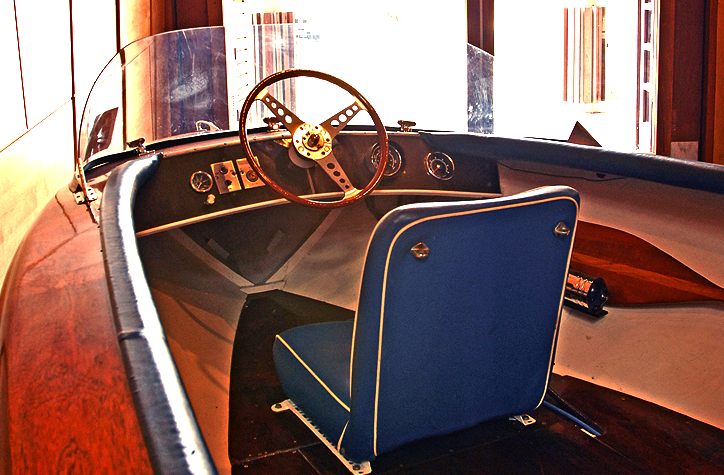
Single
seat helm in the wooden prototype Jetstar boat
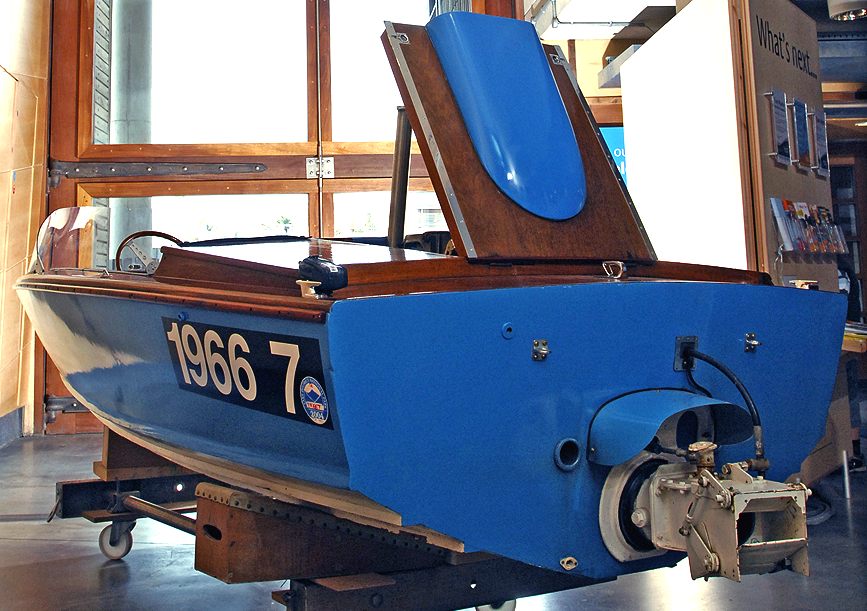
The
wooden prototype 'Jetstar boat' - a Water-jet propelled speedboat developed by late Donald Campbell.
BONHAMS
AUCTION 2nd June 2007
2 p.m. London, New Bond Street
Sports Competition and Collectors' Motor Cars
Auction 15342
400
Jetstar: Donald Campbell’s ‘Bluebird K7’ tender boat
Type: Bluebird Jetstar prototype runabout.
Length: 12ft.10in.(3.92m)
Beam: 5ft.10in.(1.78m)
Designed by Peter Milne and built at Hamble in 1966 of laminated mahogany ply, hard chine construction. Painted ‘Bluebird’ blue and white, with varnished decks.
Engine: Evinrude V4 80hp outboard power head & Hamilton jet drive, with modified propulsion head.
General arrangement:
Short foredeck, with curved acrylic windscreen to the open cockpit, central wheel steering with helmsman’s bucket seat. Aft upholstered bench seat. Aft deck, with lifting cover to engine compartment. Inventory includes an extensive collection of original spares and archival documentation relating to the history of the vessel. Also includes an all-over cover and road trailer.
Guide Price Estimate:
UK
£25,000 - 35,000
US $ 39,000 - 55,000
EU €29,000 - 41,000
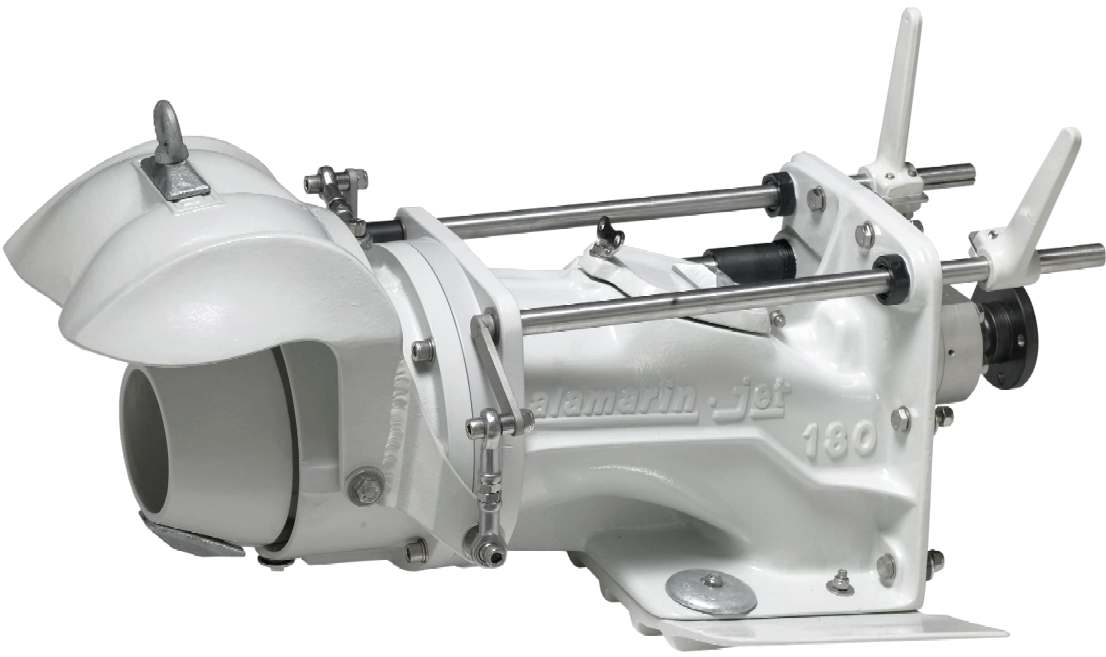
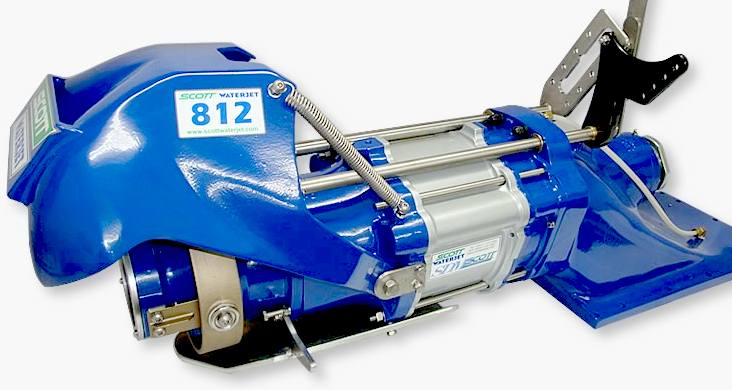
Footnotes
During his last attempt in 1966/7 to raise his own water speed record still further, Donald Campbell was also looking to secure his own personal financial future with the production of a family sized runabout speedboat and had adopted the idea of utilising and enhancing water-jet propulsion for domestic pleasure
boating. This was while he was the Director of Dowty Marine. Sir George Dowty had thrown in the towel on the concept and had branded
the boat unreliable and costly. However, Donald recognized boat's potential over traditional outboard propellers and commissioned close friends and experts to take up the
challenge:
*
Peter Milne, renowned hull designer and then Editor of Yachts &
Yachting
magazine,
*
Ken Norris, co-designer to K7 & CN7, and
*
Leo Villa, life long friend and expert mechanic to Donald and his father, Sir
Malcolm
Campbell.
Donald’s vision
was to produce 5,000 boats a year, he was quoted as saying “I wish I could get half as
excited over Bluebird and the record attempt as I am over Jetstar ”.
Accompanying Donald and the team in order to gain support for the eventual build of the craft, ‘Jetstar’ clearly proved her worth and subsequently was taken to Coniston for further trials whilst undertaking the WWSR attempt in Bluebird K7. Well documented as having played an important part of the
WWSR attempt, Donald took every opportunity to use ‘Jetstar’ on the lake when the conditions would not allow a record attempt or even just to take lucky visitors and journalists out for ‘a spin’. Donald’s team also used her to monitor K7 at close quarters whilst underway and as a general tender. The intention was then to take her along with K7 to the London Boat Show at Earls Court where clearly the publicity surrounding a new record of 300mph plus ‘in the bag’ would have been a remarkable marketing boost for the ‘Jetstar’ project.
Following Donald’s untimely and tragic accident in K7 on
Coniston, Ken Norris, Tonia Bern Campbell and Leo Villa went on to create ‘Bluebird Marine’ and set about continuing Donald’s dream, going forward to create a number of further developed ‘Jetstar’ sports boats. However, these were of fibreglass (GRP) construction and did not carry the original characteristics of this, Donald’s personal Jetstar. Apart from being the ‘hand made’ prototype that he extensively used, it carries the single seat helm position which offers a unique and exhilarating driving experience.
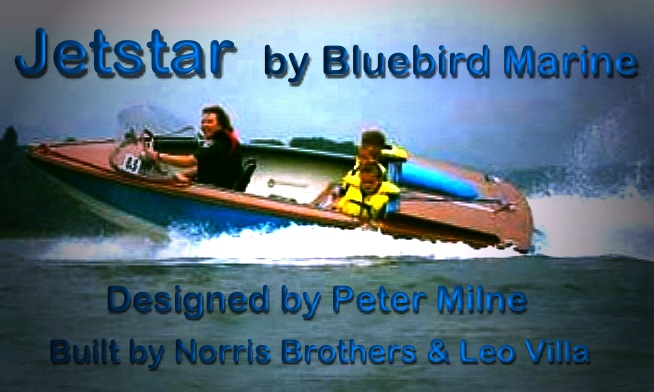
The
wooden prototype Jetstar speedboat in action
This, the original and prototype ‘Bluebird Jetstar’ utilised the proven
Hamilton Jet-drive water intake, where an impeller was powered by a V4 80hp Evinrude Outboard power head. Ken Norris produced a transmission to transfer the power to the Hamilton unit (Named by Donald as ‘The Camjet Propulsion System’) whilst at the stern, the water flow was directed again by a uniquely designed housing with hinged flaps diverting the water flow in the required direction (named by Donald as the BBVT or Bluebird Balanced Vector Thrust). This basic concept of water propulsion remaining very much in extensive use to this day.
At this auction ‘Jetstar’ was offered in running condition and retains the vast majority of her original features including seating, decks, mechanics, trim etc. having undergone only very basic maintenance and a sympathetic restoration in order to bring her back to her original 1966/7 ‘set up’.
This work was undertaken by the current owner after acquiring the historically important craft direct from Ken Norris.
‘Jetstar’ was last shown running at the Windermere Classic
Boat Rally in 2004 and has since been kept in dry storage, then displayed earlier this year at ‘The London Boat Show’ and finally being placed on view at the National Maritime Museum, Falmouth, Cornwall, in recognition of her importance.
Prior to the current owner, ‘Jetstar’ was brought back to running condition in the 1980’s by
John Ackroyd (Team Manager, Thrust II) and then displayed for public view in the foyer of the Daily Express Newspaper HQ, Fleet Street, London on the 20th Anniversary of the tragic loss of Donald Campbell.
The name Donald Campbell is synonymous with the exceptional success in World Speed Record breaking on both Land and Water and his endeavour maintained a very ‘British’ way of doing things, securing a legendary place in our history.
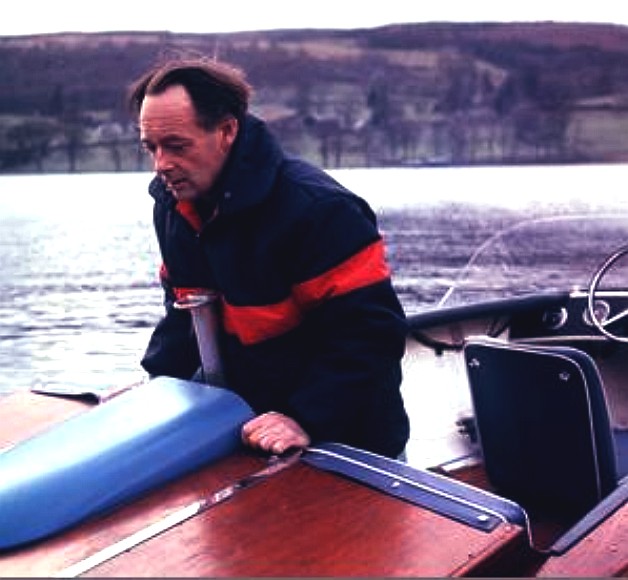
Donald
Campbell in the prototype Jetstar
MOTOR
BOAT & YACHTING March 2003
AUCTION:
Bluebird Jetstar No 1 open to bids
Fri, 14 Mar 2003 Dominic Byers/Motor Boat and Yachting Be the first to comment
If you want a rare boat with an unusual history, then a boat conceived and owned by the late Donald Campbell could be
yours - through eBay.co.uk
The first prototype Bluebird Marine Jetstar 1, which has a design speed of 34
knots, was driven by Campbell as his runabout before his untimely death. It was then lovingly restored in the early 1970s by Leo Villa, Campbell's mechanic. The Jetstar 1 had the first Dowty Hamilton drive unit, along with a much-improved steering system and a refinement of the original trim tab configuration.
If you want to join the list of prestigious pilots who have driven the boat including Leo Villa and Ken Norris, co-designer of the Bluebird K7 boat and
CN7 car, then the 10-day auction on eBay.co.uk will begin on the 25 April with viewings by appointment.
WATER
JET
DRIVES
A pump-jet, hydrojet, or water jet is a marine system that creates a jet of water for propulsion. The mechanical arrangement may be a ducted propeller
(impellor) with nozzle, or a centrifugal pump and nozzle.
A waterjet drive is like an aircraft turbojet,
the difference being that the operating fluid is water instead of air.
Water
is drawn from under the vessel and fed through a shaped inlet duct that is
flush to the hull bottom, into an inboard pump (the impeller) that rotates
like a propeller to push water out of a pipe facing backwards, so pushing
the boat forwards. A grid is fitted at the duct water inlet to protect the
impellor from wood and other flotsam, that might jam the unit.
From the pump, the water flow passes through an integrated stator which removes the water swirl generated by the impeller and converts all this pressurized energy into
straight line speed, discharging as a high-speed jet, at greater velocity than the boat speed.
The
advantage of this type of drive is greater agility. But pump-jet powered watercraft
suffer from the Coandă
effect, which must be taken into account when making changes in heading. The heading needs to be adjusted two degrees further than what would normally be required because of this effect.
Steering
is achieved by deflecting the water flow by means of directional rudders,
or a rotating nozzle. Reversing thrust is achieved by deflecting the
forward water flow using a reversing bucket, basically, a half-round tube
that is places above the waterjet and revolves on a pivot to shroud the
exit nozzle, forcing the jet flow forwards.
When the reversing deflector is placed in an intermediate neutral position, the water flow is equalized.
In this way, vertical neutral thrust can be achieved independently from the pump speed resulting in zero forward and backward thrust which keeps the boat at a
standstill. Full steering is still available for precise maneuvering and
fine trim-able forward, backward and side movements can be achieved simply by raising and lowering the reversing bucket from the neutral position and by moving the steering nozzle.
Such units though, while being great fun, are wasteful of energy (less
efficient) and far more expensive than conventional propeller and rudder
arrangements.


1.
Cutaway diagram of a waterjet drive in the normal operating positing,
pushing the boat forward. 2. The same cutaway showing the reversing bucket
deployed, so reversing thrust and pulling the boat backwards - useful for
braking - a facility that is hard to replicate with a conventional IC
engine, propeller and rudder setup, unless an electric motor is used.
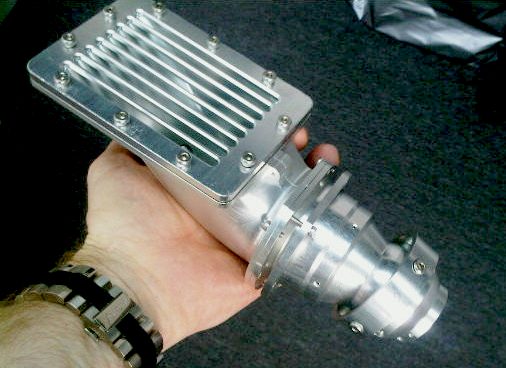
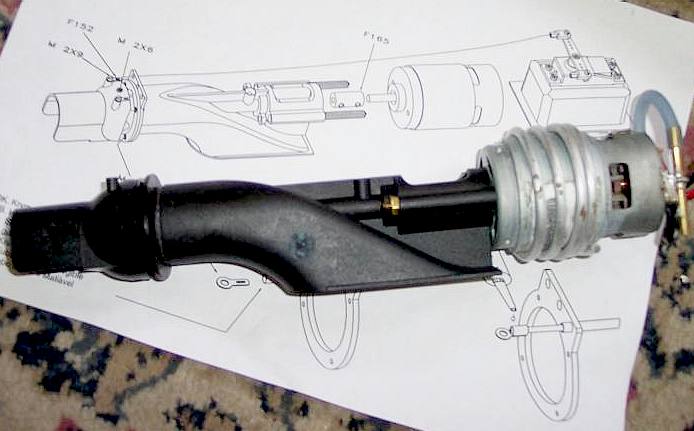
Two
small scale waterjet drives as used in many radio controlled models.
HISTORY
& USES
The Italian inventor Secondo Campini showed the first functioning man-made pump-jet engine in Venice in 1931. However, he never applied for a
patent, and since the device suffered from material problems resulting in a short life-span, it never became a commercial product. The first person to achieve that was
New Zealand inventor Sir William Hamilton in 1954.
Pump-jets were once limited to high-speed pleasure craft (such as
jet skis and jet boats) and other small vessels, but since 2000 the desire for high-speed vessels has
increased and thus the pump-jet is gaining popularity on larger craft, military vessels and
ferries. On these larger craft, they can be powered by
diesel engines or
gas
turbines. Speeds of up to 40 knots can be achieved with this configuration, even with a conventional hull.
Pump-jet powered ships are very maneuverable. Examples of ships using pumpjets are the fast patrol boat Dvora Mk-III craft, the Hamina-class missile boats, Valour-class frigates, the Stena High-speed Sea Service ferries, and the
United States littoral combat ships.
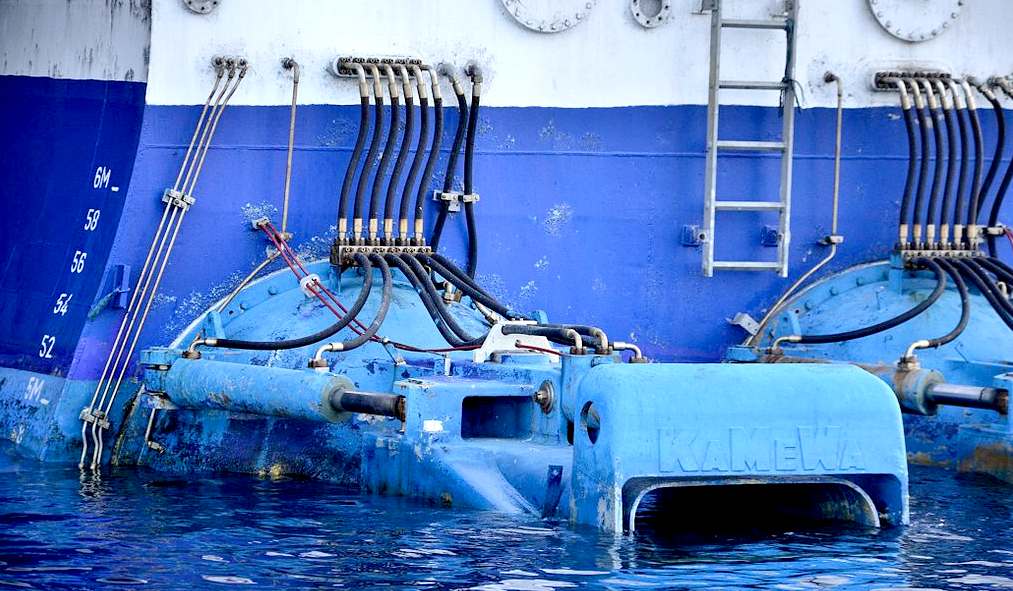
A
large waterjet drive as used on a commercial high speed ferry
CONTACT
HAMILTON
HamiltonJet Americas
14680 NE North Woodinville Way - Suite 100
Woodinville, WA 98072
Toll Free: 800.423.3509
Local: 425.527.3000
Fax: 425.527.9188
Parts Fax: 425.527.9189
www.hamiltonjet.com
info@hamiltonjet.com
Head Office and Factory
HamiltonJet
P.O. Box 709
Christchurch, New Zealand
Phone: + 64 3 348 4179
Fax: + 64 3 348 6969
www.hamjet.co.nz
HamiltonJet (U.K.) Ltd.
Unit 26 | The Birches Industries Estate
East Grinstead, West Sussex - United Kingdom
Phone: + 44 1342 313 437
Fax: + 44 1342 313 438
LINKS:
Outboard
Jets
Alibaba
jet-drives-for-boats
Castoldijet
Marine
Jet Power
Ebay
Jet-Drives
Wikipedia
Coanda effect
Wikipedia
pump-jet
Evinrude
http://www.scottjet.co.nz/
http://dowty.com/
http://outboardjets.com/
http://www.alibaba.com/showroom/jet-drives-for-boats.html
http://www.castoldijet.it/en/waterjet_en.html
http://www.marinejetpower.com/
http://www.ebay.com/sch/Jet-Drives-/177692/i.html
http://en.wikipedia.org/wiki/Coand%C4%83_effect
http://en.wikipedia.org/wiki/Pump-jet
http://www.evinrude.com/en-gb
http://www.hamiltonjet.com/
http://www.alamarin-jet.com/index.php/en/
http://www.marineclassics.co.uk/electric-boat.html
http://www.oldspeedboats.co.uk/forum/index.php?topic=1002.0
http://www.bonhams.com/auctions/15342/lot/400/
http://www.nzjetboating.com/yabbse/index.php?action=printpage;topic=7445.0
http://intheboatshed.net/2007/04/02/donald-campbells-jetstar-appears-at-the-nmm-cornwall/
http://www.cmba-uk.com/forum/viewtopic.php?f=6&t=2734
http://www.nmmc.co.uk/index.php?/collections/featured_boats/donald_campbells_bluebird_jetstar_1
http://www.mby.com/news/403537/bluebird-jetstar-no-1-open-to-bids
http://wck2.companieshouse.gov.uk/a5b1d497e0c57ed8ff9fe2b23ebcc7f2/compdetails
http://www.britishpathe.com/video/donald-campbell-speed-boat-aka-water-jet-propelled/query/Campbell
|













